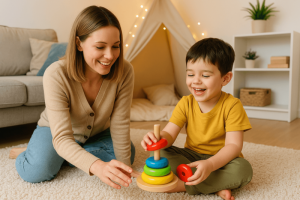How does Reinforcement work in Learning?
By Prapoorna M
Last Updated: November 25, 2021
A child can be made to learn in many ways. Knowingly or unknowingly, many of the parents follow the reinforcement techniques in order to make the child learn good behaviour.
Reinforcement
Reinforcement is strengthening of a new response by its repeated association with a stimulus. An important component of the learning process is the schedule of reinforcement. Reinforcement of certain behaviour on when and how often it is done can have a dramatic impact on the strength and rate of the response. The instances of a behaviour will be reinforced by stating a schedule of reinforcement. A behaviour might be reinforced every time it occurs and might not be reinforced at all. Responses that lead to desirable behaviours are strengthened and those are likely to be repeated, responses lead to undesirable behaviours are weakened and unlikely to be repeated.
Please click here to know more about our services
Will Reinforcement Foster Memory in Children?
Depending upon the situation, one can use either positive reinforcement or negative reinforcement. However, the goal of reinforcement remains to strengthen the behaviour and increase the likelihood that it will occur again in the future. You can follow a specific reinforcement schedule, for situations where you are purposely trying to train and reinforce an action, such as in the classroom or in sports.
There are two types of reinforcement schedules
Continuous Reinforcement
The desired behaviour can be reinforced each and every time it occurs. In order to create a strong association between the behaviour and the response, this schedule is best used during the initial stages of learning. Once the response if firmly attached, reinforcement is usually switched to a variable reinforcement schedule.
Variable Reinforcement
In Variable reinforcement, the response is reinforced only part of the time. In cases where you are specifically trying to teach a new behaviour, a continuous schedule can actually be a good choice. Once the behaviour has been learned, switching to a variable schedule is often preferable.
If the reinforcement is no longer rewarding, the subject may stop performing the desired behaviour. For example, imagine that you are trying to teach a child to write. If you are using chocolate as a reward, the child might stop performing the action once he/she is full. In such cases, something like praise or attention might be a more effective reinforcement. Positive attention and praise are the most effective rewards for desirable behaviour.

Praise as reinforcement
Praise is one of the most powerful tools parents can use to encourage good behaviour in children. Lots of praise will help make children build confidence. It costs nothing to praise a child and the great thing is that it makes feel good as well
- Praise generously and as often as possible.
- Make it a point to praise every bit of good behaviour, no matter how small
- Praise your child immediately after the good behaviour. Don’t expect them to be perfect.
- Always maintain eye contact with your child, while you do this to show your genuinity. Be enthusiastic and genuine.
- While praising, tell your child about what exactly made you praise him/her
- Keep using the words like “brilliant”, “great”, “wonderful” and tell him/her that you are proud and pleased.
- Talk only about the good behaviour you have witnessed. Don’t confuse them by being critical at the same time.
- Don’t stop praising, even if the child misbehaves after you praise him/her.
- It takes time for some children to get used to being praised before they believe they can actually change their own behaviour.
- Praise your child in front of other people who might also add to your praising words.
- Along with the verbal praise, heartfelt gestures like hugs and kisses are important to help your child learn more quickly.
- “I am really pleased when” you arranged your schoolbag. Similarly use your own creativity to praise the child.
- Do not give praise and criticism together, e.g. do not say “Well done, but why can’t you do it all the time”
- Don’t take a reward away, once you promised it. You should always follow-through the treats your child has earned.
Examples of rewards
Some of the examples of rewards that you can offer your child are
- Playing for 10 minutes
- Extra story at bedtime
- Going out doors like beach
- Doing painting
- Playing with water in the garden
- Getting a magazine
- Inviting a friend to play
- Playing video games
- Visiting a favorite cousin

What Happens?
Learning is more likely to take place when the learner understands the relationship between behaviour and consequences. The behaviour of the learner when reinforced by stimuli, learning occurs. Children learn that a certain deed is encouraged when received a positive reinforcement and they feel discouragement towards such deeds for which they receive punishments. Hence appraisal and support from parents, which work as positive reinforcement are necessary for them for the encouragement of good behaviour.
But, Negative reinforcement is somewhat different from giving punishments. Negative reinforcement is a kind of aversive stimulus. It is like a parent buying a chocolate because of the irritation caused by the child’s tantrums. The tantrums are negative reinforcement which resulted in getting what a child wants. But as such deeds shouldn’t be encouraged, Negative reinforcement should be discouraged.
Well, how do they work? Simple. As the child memorizes the results associated with the positive reinforcement, he/she is encouraged to repeat that activity. Not only the behavioural responses, but also the academic results can be influenced with reinforcement techniques. When the child is motivated in such a way, even the memory of the child improves.
Nature of memory
Many students struggle to remember lot of information and sometimes they get overwhelmed and report that their mind goes blank. Retaining information is closely related to academic success since exams are designed to test what you’ve retained from classroom and individual study.
What is memory?
Memory refers to storage and retrieval of information.
- The positive aspect of memory is retention or remembering
- The negative aspect of memory is forgetting
Three basic processes in memory
- Encoding — information into a form that can be entered into memory
- Storage—the process which we put information into a way in which we encode the information
- Retrieval—the process of getting access to the stored information and removing it out for actual use
Types of memory
- Sensory memory—visual sensory registers information for 1 second while auditory sensory register holds information for 4 to 5 seconds
- Short term memory—is a working memory where conscious mental processes are performed, can hold information for 30 seconds,
- Long term memory— unlimited capacity, permanent memory store of information for a long period of time
To know more like the techniques of memory management and how that memory should be enhanced in children, read how to improve memory in studies and how to deal with forgetfulness. Tips were also mentioned for improving attention and concentration. Some Smart reading techniques for children can also be seen.
If you feel like having a word with an expert so as to have a wholesome idea on how your children are doing and to have some tips to improve their condition, or to have a career counselling to know the next step for their better career, book an appointment, today.
FAQs for Learning and Reinforcement Techniques
1. What is reinforcement, and how does it relate to learning?
- Reinforcement is the strengthening of a new response by repeatedly associating it with a stimulus. It plays a significant role in the learning process by influencing behaviour and increasing the likelihood of its repetition.
2. What are the two types of reinforcement schedules mentioned in the text?
- The two types of reinforcement schedules are continuous reinforcement and variable reinforcement. Continuous reinforcement involves reinforcing the desired behaviour each time it occurs, while variable reinforcement only reinforces the behaviour part of the time.
3. How does positive reinforcement work in fostering memory in children?
- Positive reinforcement involves rewarding desirable behaviour, such as using praise or attention. When children receive positive reinforcement for good behaviour, they are encouraged to repeat the behaviour, which can also positively impact their memory and learning.
4. What is negative reinforcement, and how does it differ from punishment?
- Negative reinforcement involves removing an aversive stimulus to encourage certain behaviour, while punishment involves applying an aversive stimulus to discourage behaviour. Negative reinforcement is not the same as punishment.
5. What are some examples of positive reinforcement techniques mentioned in the text?
- Examples of positive reinforcement techniques include using praise generously, maintaining eye contact, praising immediately after good behaviour, and using specific and enthusiastic language.
6. Can praise and criticism be given together as reinforcement?
- No, it is recommended not to mix praise and criticism together as reinforcement. It’s best to focus solely on praising good behaviour without introducing criticism at the same time.
7. What are some examples of rewards that can be offered to children as reinforcement for good behaviour?
- Examples of rewards mentioned in the text include playing for a set time, extra story at bedtime, outdoor activities, art, video games, and social interactions with friends or family.
8. How does reinforcement influence the relationship between behaviour and consequences in children’s learning?
- Reinforcement helps children understand the relationship between their behaviour and the consequences they receive. Positive reinforcement encourages desirable behaviour, while negative reinforcement removes aversive stimuli, both of which can impact learning.
9. How can reinforcement techniques influence both behavioural responses and academic results in children?
- Reinforcement techniques can motivate children to repeat specific activities or behaviours, impacting not only their behavioural responses but also their academic performance and memory.
10. What are the three basic processes involved in memory, as mentioned in the text?
- The three basic processes in memory are encoding (converting information into a memory form), storage (retaining information), and retrieval (accessing and using stored information).
11. What are the types of memory discussed in the text?
- The text mentions three types of memory: sensory memory (short-lived), short-term memory (working memory), and long-term memory (permanent memory store).
12. Where can I find more information on memory management techniques and strategies for improving attention and concentration in children?
- The text suggests reading resources on improving memory in studies, dealing with forgetfulness, and using smart reading techniques for children. For personalized guidance, it is recommended to book an appointment with an expert.
About the Author:
Prapoorna Mangalampalli, Psychologist
Prapoorna, an author with dual master’s degrees in Psychology and English, excels in exploring and enhancing human experiences. Her writing, characterized by deep empathy and insight, primarily focuses on the complexities of counseling, spanning areas such as online, marital, relationship, child, family, and career counseling. Specialized training in various counseling sectors underscores her dedication to positive change. In her blogs, Prapoorna offers valuable guidance and a unique perspective for parents of children with Autism and special needs, creating a supportive community in this realm.
Book your Free Consultation Today
Parent/Caregiver Info:
Client’s Details:
* Error Message






